Looking for a low-maintenance houseplant that will improve your home? Check out these Amazing Spider Plant Benefits proven by science!

Here are Spider Plant Benefits, from improving air quality by purifying the surrounding environment to their adaptability. Learn why these are the best green companions to bring to your home.
What Is a Spider Plant?
A Spider plant (Chlorophytum comosum) is a popular and easily recognizable indoor plant known for its unique appearance and air-purifying qualities. It belongs to the Asparagaceae family and is native to South Africa.
The spider plant is commonly grown as a houseplant and is valued for its low maintenance requirements and ability to adapt to a variety of indoor conditions.
Spider Plant Benefits
1. Safe For Pets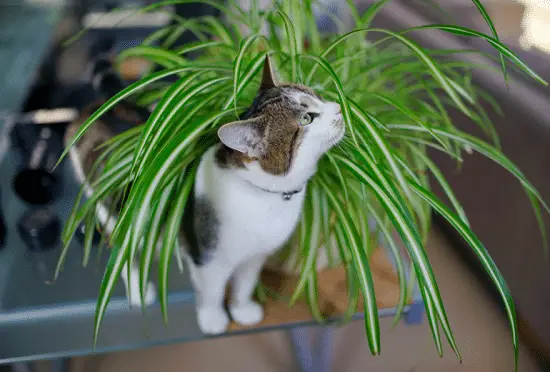
When you’re picking a plant to freshen up your indoor air, making sure it’s safe for your furry friends is a must.
According to the ASPCA, spider plants are totally fine for your cats and dogs to be around. There is no proof that spider plants could be harmful to your pets. So, with a spider plant in your space, you’re not only making the air better but also keeping your four-legged pals safe and sound.
2. Clean Up the Atmosphere
This National Wildlife Federation claims that the spider plant removes more than 95 percent of toxic agents from the air.
Spider plants are like natural air purifiers. They take in harmful gases like formaldehyde and xylene, which are found in furniture and cleaning products.
Reduce Carbon Monoxide
Carbon monoxide is a silent, invisible gas without smell, color, or taste. It forms when fuels like wood, petrol, coal, and natural gas burn incompletely. It is extremely harmful to humans, and the CDC lists all of its health risks on its website.
Spider plants help lower indoor carbon monoxide, reducing fatigue, headaches, and other symptoms.
Decrease Formaldehyde Levels
Formaldehyde is another chemical that spider plants help remove. This colorless, pungent chemical is listed as toxic by WHO. It’s used in building materials like particle board. Smoking, painting, cooking, and traffic also contribute to it.
However, research shows spider plants can decrease formaldehyde by 88% in 24 hours. Other studies support this finding.
Reduction of Xylene
Xylene, a solvent, is found in various industries and products. Poorly ventilated buildings elevate indoor levels. It causes skin, eye, and lung irritation, breathing problems, and more. NCBI identifies xylene as a health hazard.
But you’re safe if you have a spider plant or a snake plant, as these reduce Xylene and clean up the air.
3. Lead Tolerance and Removal
Unlike some plants that can’t handle soils with heavy metals like lead, spider plants are real troopers.
In fact, a study found that spider plants could thrive in soils with as much as 500 mg of lead per kilogram of dry soil.
But wait, there’s more! Another study discovered something really interesting about spider plants. It turns out they could be like nature’s little helpers for cleaning up lead-contaminated soil.
So, having spider plants around isn’t just about having a nice decoration – they’re like the eco-friendly champions of your soil’s well-being!
4. Taking Care of Particulate Matter
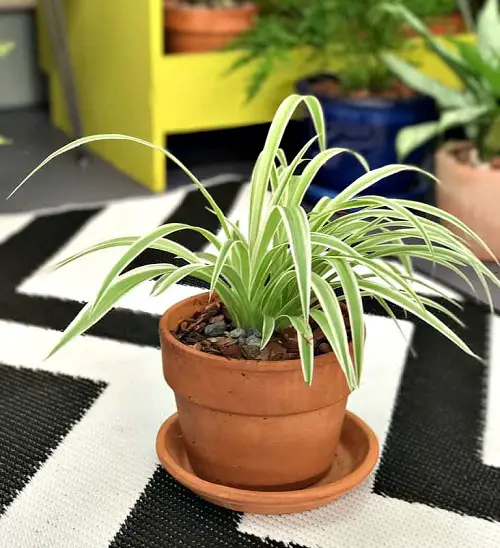
The spider plant, renowned for its air-purifying capabilities, goes beyond merely enhancing indoor air quality. Notably, this remarkable plant is a potent guardian against one of the most detrimental pollutants to human health – Particulate Matter.
These minute particles, often unseen to the naked eye, possess the insidious ability to infiltrate your respiratory system and bloodstream, instigating a range of adverse effects.
By harnessing its innate detoxifying prowess, the spider plant mitigates the impact of these harmful particles.
In essence, it acts as a formidable shield against the intrusion of Particulate Matter, effectively contributing to a healthier and more breathable indoor environment.
5. Lower Your Stress
Feeling calm and relaxed around plants, like spider plants, isn’t just in your head – it’s real! Science backs up the soothing effect that plants can have on us, helping to ease stress and anxiety.
In one interesting study, researchers wanted to see how being around plants, whether inside or through a window view, affected people. Guess what? When participants had a view of nature or were surrounded by indoor plants, they actually felt less nervous and anxious.
And here’s something else neat: Plants might also act as a shield against the stresses of technology. In 2015, there was a study in which folks were split into two groups.
One group got to hang out with plants, while the other group did a computer task. Afterward, the plant group had lower blood pressure and said they felt more comfy and relaxed.
6. Absorbing Nitrogen Dioxide

You’re in for a pleasant surprise with spider plants! Not only are they charming houseplants, but they also have an amazing superpower – the ability to soak up nitrogen dioxide, a sneaky pollutant that can actually cause quite a bit of trouble.
Nitrogen Dioxide often lurks in the air, coming from sources such as car exhaust and some household appliances.
Your trusty spider plant acts like a superhero against this harmful gas. It absorbs Nitrogen Dioxide and makes your air cleaner and safer to breathe. So, while you’re enjoying the beauty of your spider plant, it’s quietly working to keep you healthier, too.
7. Improving Productivity and Focus
If you’re having a hard time staying on track at work and you notice your productivity isn’t what it used to be, you need to make the most of spider plant benefits. It turns out that having plants, like spider plants, around your workspace can bring some positive vibes.
Check this out: researchers decided to see what happens when you put plants in a room without windows. The folks who tackled tasks close to plants had a reaction time that was 12% faster than those who didn’t have plants around.
Plants like spider plants don’t just make you quicker – they’re like focus boosters, too. A study from 2011 found that having plants around can actually help fight off that tired feeling that creeps in when you’re working. This means you can stay sharp and keep your attention where needed.
8. Increase Humidity Naturally
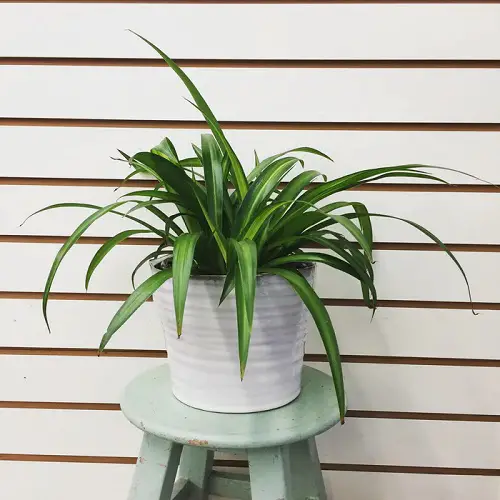
Spider plants are like your home’s natural humidity helpers – no need for fancy plug-in humidifiers. You see, having the right amount of humidity is important.
Too much can lead to problems, but if the air is too dry, it can worsen health issues like breathing troubles, skin woes, and even sore throats.
After you water your spider plant, it works its magic for about 12 hours. The water droplets from the watering start to evaporate, helping increase the humidity around you.
The process is called Evapotranspiration. Don’t believe us? Here’s the study to prove another of the unique spider plant benefits.
9. Better Quality of Sleep
Spider plants have another amazing talent – they can actually help improve your sleep! While most plants take a break and stop making oxygen at night, spider plants are the night owls of the plant world. They keep on releasing oxygen even after the sun sets.
This nighttime oxygen boost can be a game-changer for your sleep quality. Spider plant benefits are like having a natural air purifier that keeps the air fresher while you’re dozing off.
Note: All these spider plant benefits are based on research. However, you should exercise caution. Before making any decisions, consider conducting your own research or seeking advice from professionals to ensure the best outcomes for your specific situation.
Spider Plant Facts
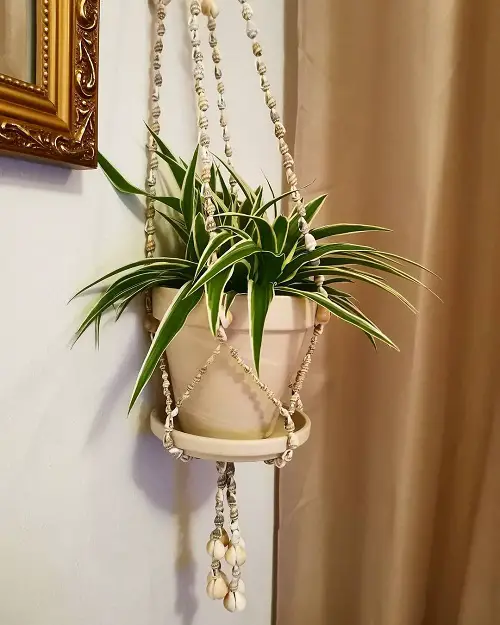
- Spider plants have a hidden talent beyond air purification – they’re among a unique group of plants capable of “CAM” photosynthesis.
- In certain African regions, the plant’s long, pointed leaves are traditionally used to treat burns, wounds, and other minor injuries.
- While spider plants are most renowned for their arching foliage, they occasionally surprise their caretakers with delicate, small white flowers that bloom on long stems.
- In addition to their air-cleansing attributes, spider plants possess a lesser-known talent – they’re natural ionizers. Through the process of transpiration, spider plants release negatively charged ions into the air.
Spider Plant Disadvantages
While spider plant benefits are many, there are a few potential disadvantages you should know.
- Brown Tips: The plant’s leaves can develop brown tips due to tap water containing fluoride or chlorine; filtered or distilled water is recommended.
- Overwatering Risk: Overwatering can lead to root rot; it’s crucial to allow the soil’s top layer to dry out between waterings.
- Pest Vulnerability: Spider plants are susceptible to pests like spider mites and mealybugs, requiring regular monitoring and pest control.
- Overcrowding Concerns: The plant’s rapid production of offshoots can lead to overcrowding in the pot, affecting its appearance and growth.
- Cold Sensitivity: Exposure to cold temperatures or drafts can harm the plant’s leaves; it should be kept away from cold environments.
Snake Plant vs Spider Plant
The confusion between Snake plants (Sansevieria) and Spider plants (Chlorophytum comosum) arises from their popularity and similar reputation as easy-to-care-for indoor plants.
Despite their distinct features, people often compare them due to their shared qualities. Snake plants boast upright, sword-like leaves with unique patterns resembling snakeskin, while spider plants feature cascading, arching leaves adorned with striking green and white stripes.
Snake plants are renowned for their tolerance of low light and infrequent watering, while spider plants are prized for their air-purifying qualities and adaptability to different light conditions. Ultimately, the choice between these two captivating plants depends on one’s preference for vertical elegance or cascading charm, along with considerations of care routine and aesthetic appeal.
Want more Spider Plant Babies? Click here
Where to Keep Spider Plants at Home?
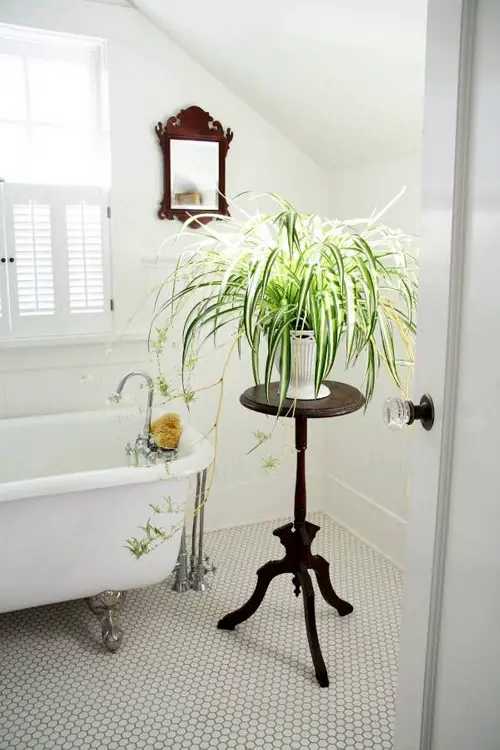
LYou can place them on shelves, tables, or hanging planters, allowing their graceful leaves to cascade elegantly. These plants also enjoy being part of your indoor decor, adding a touch of green to living rooms, bedrooms, or even home offices.
Spider plants are quite versatile regarding their placement in your home. Just be cautious not to expose them to direct sunlight for extended periods, as it can scorch their leaves. With their adaptability and air-purifying qualities, spider plants can find a cozy spot in various corners of your home, including a bathroom!




Does a spider plant repel any insects.
No